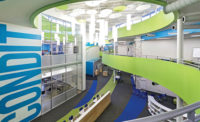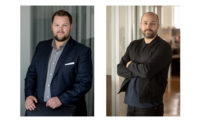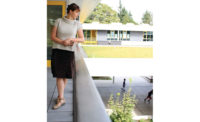McDonald's by Ross Barney Architects
Chicago

Diners enjoy a view into a portion of the roof that appears punched through to let a trough of trees sit low in the space but separated from diners by glass walls.
Photo © Kendall McCaugherty/Steve Hall + Nick Merrick Photographers

A pergola made of solar panels shelters the building and its outdoor dining area and the drive-through.
Photo © Kendall McCaugherty/Steve Hall + Nick Merrick Photographers

An interior wall of plants is among the green areas created by local firm Omni Ecosystems.
Photo © Kendall McCaugherty/Steve Hall + Nick Merrick Photographers

Glass walls allow for natural illumination when daylight sensors turn off interior LEDs.
Photo © Kendall McCaugherty/Steve Hall + Nick Merrick Photographers

Ross Barney Architects reduced the property’s parking by 40 percent and increased its green space by 72 percent.
Photo © Kendall McCaugherty/Steve Hall + Nick Merrick Photographers





Architects & Firms
Just when it seemed high-end design could not get more mainstream, a gleaming glass restaurant erected on the spot once occupied by Chicago’s Rock ‘n’ Roll McDonald’s has breached new ground—a fast-food drive-through.
While the 269-seat establishment is still a McDonald’s, its new cube-shaped profile by Ross Barney Architects is also a tech-y homage to the future: It is built from the latest sustainable sensation (cross-laminated timber); wrapped in a light-giving, bird-friendly glazing; and bursting with green features such as a rooftop apple orchard, parkland, pervious paving, green-vehicle charging stations, and 1,062 solar panels that can generate up to 60 percent of its electrical energy.
Viewed from the street, the restaurant is a transparent cube that contains a smaller cube full of trees—one of the properties green roofs. Seen from inside the restaurant, the trees appear planted on a mezzanine-height platform at the center of the space that is enclosed in glass walls up to the ceiling. Beneath it, two rows of kiosks line a walkway formed by half-height walls separating dining areas on either side. Back outside, a drone’s eye view would take in the vast pergola, which holds the solar panels and shelters the building and its surrounding walkways.
The look heralds a new direction for the brand. “More contemporary designs are in the works around the U.S.,” confirms Maximiliano Carmona, McDonald’s senior director of global design and development. (See interview, page 14.) But those restaurants will likely be completed with different architects, leaving the 19,000-square-foot Ross Barney-designed location as a one-off special attraction. “We can’t just duplicate this anywhere. The site is unique because of its size compared with our typical restaurants, which are around 4,000 to 5,000 square feet,” Carmona says. “What this project does is demonstrate what a progressive McDonald’s could look like.”
Fresh from designing Chicago’s Riverwalk, Carol Ross Barney, the homegrown founder of her eponymous firm, was a natural fit for the modernizing brand. (The company also relocated its headquarters from the suburbs into a hip new office by Gensler in Chicago’s West Loop.)
“I grew up in Chicago. My parents moved to the suburbs when I was five. I remember McDonald’s as a piece of American culture,” says Ross Barney. “We associate it with suburbia and standardization, but [design] is the way its brand will survive compared with the likes of Sears and Wards department stores.”
As a proponent of “design as a right, not a privilege,” Ross Barney took steps to make the franchise-owned site an inviting community hub with more public space and 40 percent less parking than its predecessor. “If it were up to Carol, the entire property would be a park,” says Carmona with a warm laugh. But retail profits must be prioritized, so the drive-through remains. “It’s over half their business,” Ross Barney points out, adding “We are car creatures.”










